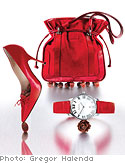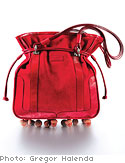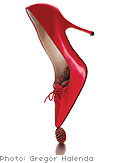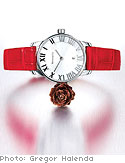

Find quality and function in one sleek package.
Big bags are in, but that extra weight can strain your back. Our solution is the "lunch" bag: a clutch tucked inside your tote to take along when you leave the office to eat or do errands.
Exotic skins can be imitated successfully with embossed leather or vinyl. "Ostrich skin reproduces so well, you almost can't tell real from fake," says Desire Smith, author of Handbag Chic and Fun Handbags.
Pebbled leather won't show scratches as much as smooth; it's usually more resilient.
Watch out for reconstituted leather—this cheesy stuff is made from leather scraps fused with other materials: It feels cardboardy, cracks easily, looks chalky on the reverse side.
Decent hardware has weight and well-soldered rings and chains. Silver, brass, or nickel is most practical; when gold-plated hardware is nicked, the base metal underneath is exposed and things get ugly.
Inner space is simpler to organize with two or three pockets. Faille, rayon, or vinyl linings in dark colors (won't show stains) are most durable.
Evening purses in metal mesh wear better than fabric ("If a water spot gets on silk, it's done," Smith says). Embellishments, often glued on, are too fragile for bags in heavy rotation.
Bag rentals—to test-drive new styles or get one-night custody of a megawatt clutch—are available at bagborroworsteal.com.
Pictured above: Roomy but not huge, soft but not shapeless, this red drawstring pouch (Kate Spade, $545) is an excellent foil for the ubiquitous black clothes in our closets.
Big bags are in, but that extra weight can strain your back. Our solution is the "lunch" bag: a clutch tucked inside your tote to take along when you leave the office to eat or do errands.
Exotic skins can be imitated successfully with embossed leather or vinyl. "Ostrich skin reproduces so well, you almost can't tell real from fake," says Desire Smith, author of Handbag Chic and Fun Handbags.
Pebbled leather won't show scratches as much as smooth; it's usually more resilient.
Watch out for reconstituted leather—this cheesy stuff is made from leather scraps fused with other materials: It feels cardboardy, cracks easily, looks chalky on the reverse side.
Decent hardware has weight and well-soldered rings and chains. Silver, brass, or nickel is most practical; when gold-plated hardware is nicked, the base metal underneath is exposed and things get ugly.
Inner space is simpler to organize with two or three pockets. Faille, rayon, or vinyl linings in dark colors (won't show stains) are most durable.
Evening purses in metal mesh wear better than fabric ("If a water spot gets on silk, it's done," Smith says). Embellishments, often glued on, are too fragile for bags in heavy rotation.
Bag rentals—to test-drive new styles or get one-night custody of a megawatt clutch—are available at bagborroworsteal.com.
Pictured above: Roomy but not huge, soft but not shapeless, this red drawstring pouch (Kate Spade, $545) is an excellent foil for the ubiquitous black clothes in our closets.

A heel-to-toe checklist for value, stability, and fit.
Happy feet are usually dressed in softer, more pliable leather. "It has memory—it molds to the foot," says Gordon Thompson III, creative director of Cole Haan. Well-made shoes also have flexible leather soles.
No-show construction is important: The better crafted a shoe is, the more seamless it should look, with no visible glue or staples.
Less weight often correlates with greater quality. Heavier shoes (other than work boots) signal bulkier, less refined components.
Unfinished insides aren't comfortable, no matter how cute the outside. A leather lining is best because it absorbs excess moisture and has enough "give" to allow the foot to swell slightly.
High heels can feel wobbly if they're very thin at the top, where they're attached to the sole. Wedges and chunkier heels are more stable because weight is distributed over a wider area.
Buying too tight—and hoping the fit will ease up over time—is the number one mistake people make. "If a shoe pinches, no amount of stretching will make it comfortable," says shoe designer Patricia Green.
Buying too high is another problem, says Thompson: "Women often wear heels that they can't comfortably walk in."
Buying too short is an issue with sandals: The foot should sit squarely on the sole of the shoe, with no toe spillover.
Pictured above: Rich and thin is a powerful combination. Shock the office (pleasantly) with these jewel-tone patent leather stilettos (Manolo Blahnik, $575).
Happy feet are usually dressed in softer, more pliable leather. "It has memory—it molds to the foot," says Gordon Thompson III, creative director of Cole Haan. Well-made shoes also have flexible leather soles.
No-show construction is important: The better crafted a shoe is, the more seamless it should look, with no visible glue or staples.
Less weight often correlates with greater quality. Heavier shoes (other than work boots) signal bulkier, less refined components.
Unfinished insides aren't comfortable, no matter how cute the outside. A leather lining is best because it absorbs excess moisture and has enough "give" to allow the foot to swell slightly.
High heels can feel wobbly if they're very thin at the top, where they're attached to the sole. Wedges and chunkier heels are more stable because weight is distributed over a wider area.
Buying too tight—and hoping the fit will ease up over time—is the number one mistake people make. "If a shoe pinches, no amount of stretching will make it comfortable," says shoe designer Patricia Green.
Buying too high is another problem, says Thompson: "Women often wear heels that they can't comfortably walk in."
Buying too short is an issue with sandals: The foot should sit squarely on the sole of the shoe, with no toe spillover.
Pictured above: Rich and thin is a powerful combination. Shock the office (pleasantly) with these jewel-tone patent leather stilettos (Manolo Blahnik, $575).

Putting the right time on your wrist—the anatomy of accuracy.
A watch wardrobe: Owning a few styles—fine, fancy, or cheap—allows you to match your timepiece to your outfit or mood.
Metal straps last longest. If you prefer leather, get a deployant buckle: Because it folds over and snaps, this clasp puts less stress on the band, extending its life.
Best-case scenario is stainless steel: It resists rust, discoloration, and scratches better than cheaper alloys.
A quartz watch never needs winding; a mechanical one requires it daily; an automatic has a weight inside that swings as the wearer moves, keeping it wound. If it isn't worn daily, an automatic has to be reset (and wound manually once a week or so, says Joseph M. Urich, publisher of hr: Watches magazine).
A chronometer is a watch certified to meet international standards of accuracy; a chronograph has a stopwatch with extra dials for seconds, minutes, and hours.
Taking a swim or shower with a watch labeled water resistant isn't risk-free. "If the case has ever been opened, even to change the battery, that could compromise the seal," says Norma Buchanan, contributing editor at WatchTime magazine.
For cleaning the works and polishing out scratches, go to a jewelry store with a resident watchmaker.
Pictured above: With its streamlined roman numerals and vivid alligator strap, a pristine stainless steel watch (Tiffany & Co., $1,500; red strap, $180) is the epitome of a modern time machine.
A watch wardrobe: Owning a few styles—fine, fancy, or cheap—allows you to match your timepiece to your outfit or mood.
Metal straps last longest. If you prefer leather, get a deployant buckle: Because it folds over and snaps, this clasp puts less stress on the band, extending its life.
Best-case scenario is stainless steel: It resists rust, discoloration, and scratches better than cheaper alloys.
A quartz watch never needs winding; a mechanical one requires it daily; an automatic has a weight inside that swings as the wearer moves, keeping it wound. If it isn't worn daily, an automatic has to be reset (and wound manually once a week or so, says Joseph M. Urich, publisher of hr: Watches magazine).
A chronometer is a watch certified to meet international standards of accuracy; a chronograph has a stopwatch with extra dials for seconds, minutes, and hours.
Taking a swim or shower with a watch labeled water resistant isn't risk-free. "If the case has ever been opened, even to change the battery, that could compromise the seal," says Norma Buchanan, contributing editor at WatchTime magazine.
For cleaning the works and polishing out scratches, go to a jewelry store with a resident watchmaker.
Pictured above: With its streamlined roman numerals and vivid alligator strap, a pristine stainless steel watch (Tiffany & Co., $1,500; red strap, $180) is the epitome of a modern time machine.




